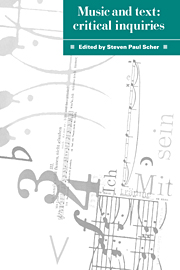Book contents
- Frontmatter
- Contents
- List of figures
- List of contributors
- Preface
- Acknowledgments
- Part I Institutional dimensions and the contexts of listening
- Part II Literary models for musical understanding: music, lyric, narrative, and metaphor
- 4 Lyrical modes
- 5 Origins of modernism: musical structures and narrative forms
- 6 Metaphorical modes in nineteenth-century music criticism: image, narrative, and idea
- 7 Narrative archetypes and Mahler's Ninth Symphony
- Part III Representation, analysis, and semiotics
- Part IV Gender and convention
- Index
6 - Metaphorical modes in nineteenth-century music criticism: image, narrative, and idea
Published online by Cambridge University Press: 04 September 2009
- Frontmatter
- Contents
- List of figures
- List of contributors
- Preface
- Acknowledgments
- Part I Institutional dimensions and the contexts of listening
- Part II Literary models for musical understanding: music, lyric, narrative, and metaphor
- 4 Lyrical modes
- 5 Origins of modernism: musical structures and narrative forms
- 6 Metaphorical modes in nineteenth-century music criticism: image, narrative, and idea
- 7 Narrative archetypes and Mahler's Ninth Symphony
- Part III Representation, analysis, and semiotics
- Part IV Gender and convention
- Index
Summary
In the course of his famous treatise on The Beautiful in Music, Eduard Hanslick pointed to a perennial dilemma facing the critic of music: the fact that it “has no model in nature, it expresses no conceptual content.” To gain verbal access to a composition, the critic is forced to choose between “dry technical designations” or else “poetic fictions,” in Hanslick's words. Despite his reputation as a formalist, Hanslick clearly does not advocate here a purely technical discourse – which he accuses of dryness – over a more poeticizing style of interpretation. His point is merely that “poetic” discourse about music must be recognized for what it is, fiction rather than fact. “What is simply description in the other arts,” he adds, “is already metaphor in music.”
Such metaphorical discourse has always been recognized as an indispensable, if troublesome, component of musical criticism. It is commonly called upon to moisten a bit those “dry technical designations,” making them somewhat easier to swallow and perhaps enhancing their essential blandness – for wider audiences – with a certain piquancy of flavor. Conversely, a degree of analytical detail is generally thought necessary to provide some substantive base for the volatile nature of metaphorical impressions. That the two can and should be complementary is perfectly obvious, although it doesn't invalidate Hanslick's formulation of the critic's dilemma: the critic may not be faced with a choice between irreconcilable alternatives, but he still bears responsibility for striking a successful, convincing balance between them.
- Type
- Chapter
- Information
- Music and TextCritical Inquiries, pp. 93 - 117Publisher: Cambridge University PressPrint publication year: 1992
- 5
- Cited by



